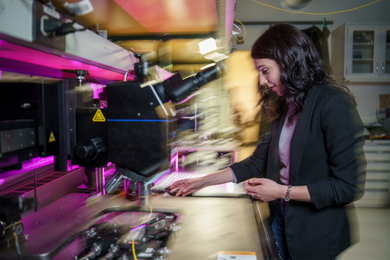Experts in wireless sensing and implantable electronics convened at the MIT Media Lab last week for the Body Sensor Network (BSN) 2006 International Workshop, an event highlighting the dramatic changes that computing innovations have made in health care and health monitoring.
The event was a "whirlwind tour through cutting-edge aspects of wearable and pervasive computing, biosensors and implantable systems and medical, clinical and ubiquitous computing applications," said Joseph Paradiso, director of the Media Lab's Responsive Environments Group and co-organizer of the 3-year-old international event.
The BSN workshops, held April 3-5 in Bartos Theater, included presentations and poster sessions covering such topics as wearable and implantable sensors, clinical applications and ways to power these new systems.
Paradiso noted in his introduction to the proceedings, "We hope this workshop becomes a Rosetta Stone that keeps us all communicating to build out the future of physiological interfaces between people and computation."
Postdoctoral associate Rana el Kaliouby, graduate student Alea Teeters and Professor Rosalind Picard of media arts and sciences, all of the MIT Media Lab, led the session on clinical applications with a moving presentation on how a small video camera worn on a chest-height antenna might be used as a "social-emotional prosthetic" to help people with autism spectrum disorders learn to identify and decode their own and others' facial expressions.
John Wyatt, professor of electrical engineering and computer science, described his work in developing a retinal implant for the blind. His paper describes how an implant containing a 10-micron-thick microelectrode array could restore a "useful level of vision" to patients suffering from outer retinal diseases, such as macular degeneration.
Other presenters on clinical applications showed how sensors applied to the arm can assess the motor abilities and progress of people recovering from strokes; how a pervasive body sensor network could monitor recovery of postoperative patients; and how a wireless sensor system might assess and aid in treating dyskinesia, the involuntary writhing movements associated with Parkinson's disease.
Wearable sensors, many of which look like they're straight out of gadget-casting for Xenon, Girl of the Future, promise profound and potentially life-saving changes in health care.
BSN presenters offered examples from around the world, including
HealthGear, a real-time wearable system that monitors blood oxygen during sleep and may detect sleep apnea; "smart" clothes, such as the MyHeart instrumented shirt, a close-fitting sleeveless T with electrodes embedded in the fabric; and the EKG shirt, a prototype for a sensing T-shirt that measures an EKG signal through circuitry that has been embroidered on it with conductive yarn.
Smart clothes can be bulky. Eric Wade, a graduate student in mechanical engineering, and H. Harry Asada, the Ford Professor of Mechanical Engineering, presented a paper on simplifying routing among connectors and integrating systems that use conductive fabrics, which are made of nylon and polyester with a silver, nickel or aluminum coating. They propose using one system to transmit both power and data between the central node and sensor nodes within a system. Asada is director of the Brit and Alex D'Arbeloff Laboratory for Information Systems and Technology.
BSN sessions also focused on how to provide power to fabrics and gadgets for computation and how to protect individual privacy and security. One challenge for developers of smart clothing, for example, is management of the huge data volume that results when patients wear clothes or devices that are literally packed with sensors. Another concern is privacy and security of medical information.
A version of this article appeared in MIT Tech Talk on April 12, 2006 (download PDF).






